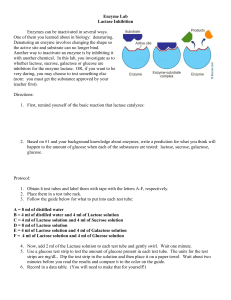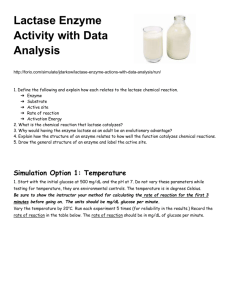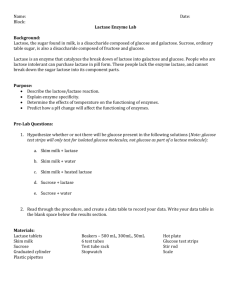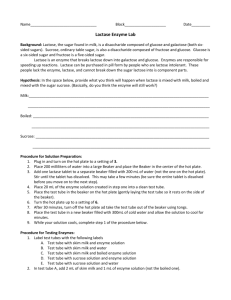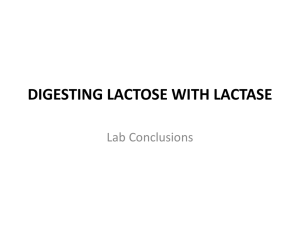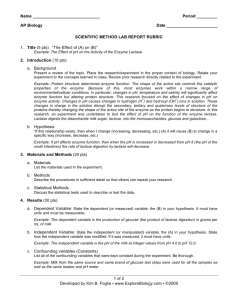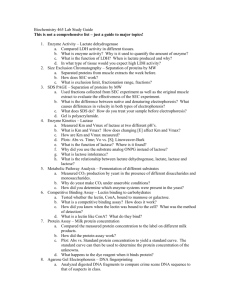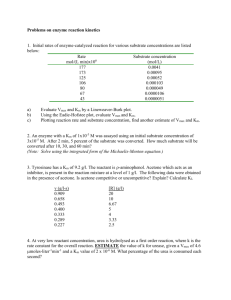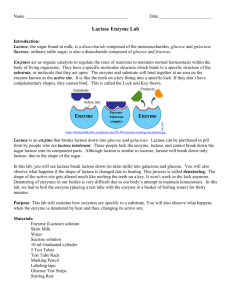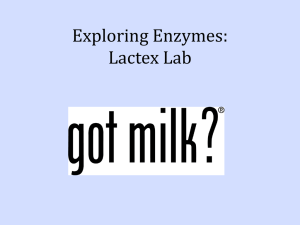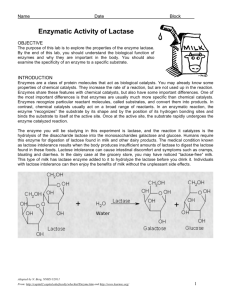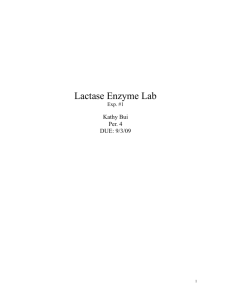Enzyme Lab Report
advertisement
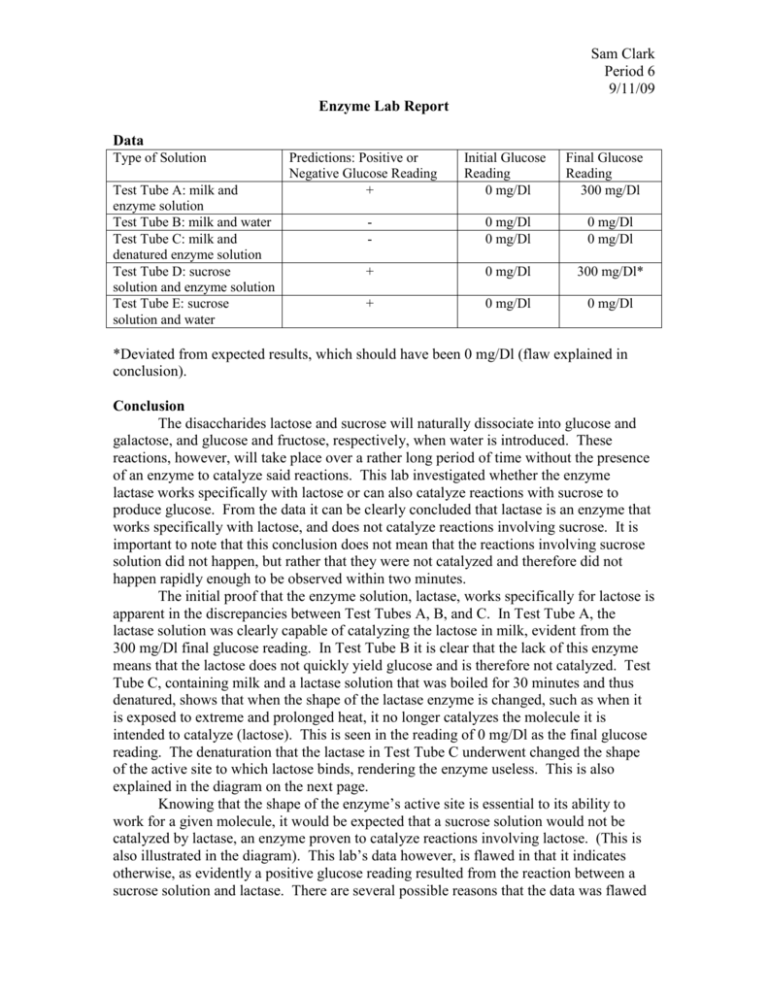
Sam Clark Period 6 9/11/09 Enzyme Lab Report Data Type of Solution Test Tube A: milk and enzyme solution Test Tube B: milk and water Test Tube C: milk and denatured enzyme solution Test Tube D: sucrose solution and enzyme solution Test Tube E: sucrose solution and water Predictions: Positive or Negative Glucose Reading + Initial Glucose Reading 0 mg/Dl Final Glucose Reading 300 mg/Dl - 0 mg/Dl 0 mg/Dl 0 mg/Dl 0 mg/Dl + 0 mg/Dl 300 mg/Dl* + 0 mg/Dl 0 mg/Dl *Deviated from expected results, which should have been 0 mg/Dl (flaw explained in conclusion). Conclusion The disaccharides lactose and sucrose will naturally dissociate into glucose and galactose, and glucose and fructose, respectively, when water is introduced. These reactions, however, will take place over a rather long period of time without the presence of an enzyme to catalyze said reactions. This lab investigated whether the enzyme lactase works specifically with lactose or can also catalyze reactions with sucrose to produce glucose. From the data it can be clearly concluded that lactase is an enzyme that works specifically with lactose, and does not catalyze reactions involving sucrose. It is important to note that this conclusion does not mean that the reactions involving sucrose solution did not happen, but rather that they were not catalyzed and therefore did not happen rapidly enough to be observed within two minutes. The initial proof that the enzyme solution, lactase, works specifically for lactose is apparent in the discrepancies between Test Tubes A, B, and C. In Test Tube A, the lactase solution was clearly capable of catalyzing the lactose in milk, evident from the 300 mg/Dl final glucose reading. In Test Tube B it is clear that the lack of this enzyme means that the lactose does not quickly yield glucose and is therefore not catalyzed. Test Tube C, containing milk and a lactase solution that was boiled for 30 minutes and thus denatured, shows that when the shape of the lactase enzyme is changed, such as when it is exposed to extreme and prolonged heat, it no longer catalyzes the molecule it is intended to catalyze (lactose). This is seen in the reading of 0 mg/Dl as the final glucose reading. The denaturation that the lactase in Test Tube C underwent changed the shape of the active site to which lactose binds, rendering the enzyme useless. This is also explained in the diagram on the next page. Knowing that the shape of the enzyme’s active site is essential to its ability to work for a given molecule, it would be expected that a sucrose solution would not be catalyzed by lactase, an enzyme proven to catalyze reactions involving lactose. (This is also illustrated in the diagram). This lab’s data however, is flawed in that it indicates otherwise, as evidently a positive glucose reading resulted from the reaction between a sucrose solution and lactase. There are several possible reasons that the data was flawed Sam Clark Period 6 9/11/09 as such. First, it is possible that the glucose test strip was defective. Second, it is possible that there was a degree of user error and the experiment-performer accidentally used milk instead of sucrose solution. This is a quite likely scenario given that the results of the final glucose reading—300 mg/Dl—were the same for both Test Tube A and D. Third, it is possible that the test tubes became cross-contaminated due to poor cleaning. All three of these problems could have been fixed with easy improvements to the experiment. First and easiest, cleaning the equipment more diligently before the experiment would have eliminated the possibility of the third potential reason for error. The most important change however, would have been to perform multiple trials. This would solve the first problem, for if there was a defective test strip the performance of several trials would ensure that the most consistent reading, or that of the non-defective test strips, would be reflected in the data. It would also solve the problem of user error, as the testers would recognize the problem and confusion with multiple trials. This lab was overall quite successful and can lead to the clear conclusion that lactase is an enzyme that (unless denatured) only catalyzes reactions involving lactose and does not catalyze reactions involving sucrose, because the enzyme works based on the shape of the molecule fitting into the shape of the active site. QuickTime™ and a TIFF (Uncompressed) decompressor are needed to see this picture. If the above enzyme is lactase and the substrate is lactose, than the diagram illustrates the need for lactose to have a specific shape around which lactase will bind. If the substrate were a different shape, such as sucrose, or if the enzyme were a different shape, such as if it were denatured, than the binding would not take place and therefore the reaction would not be catalyzed.
